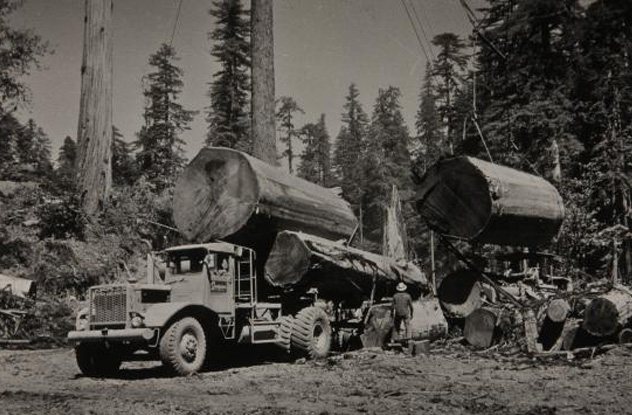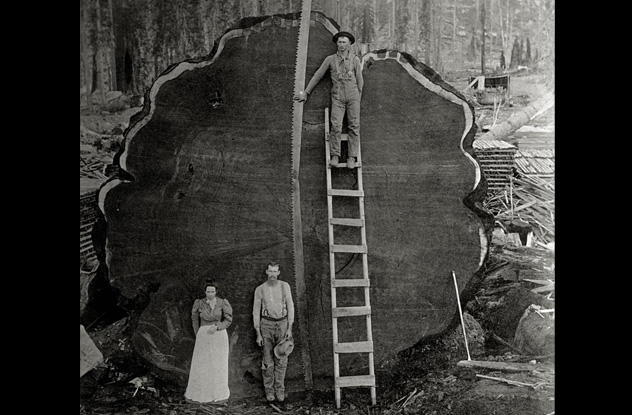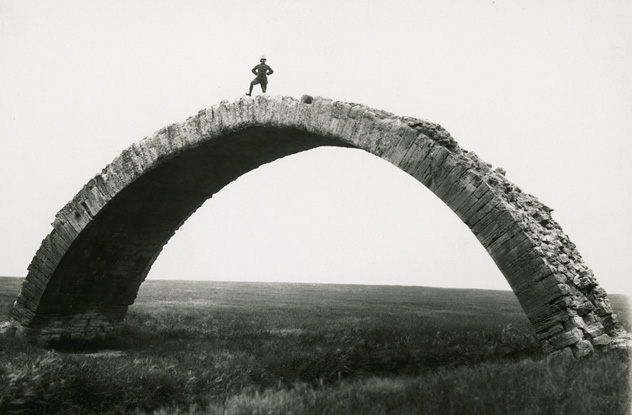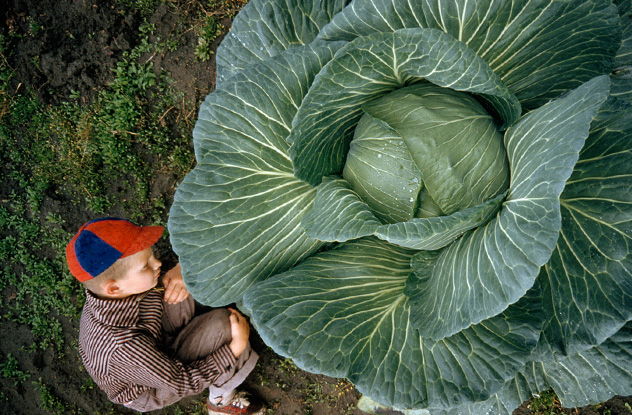5.遭砍伐的大红杉
The oldest living giant sequoia (giant redwood) on record was 3,500 years old. It was aged based on its trunk rings, so it had to die to get the record.
据记载,目前世界上最古老的大红杉树龄已达3500年。由于我们只能通过树的年轮来判断其年龄,所以只有在树木死后,其树龄才会被记录在案。

The giant redwoods of California are an iconic image of Americana, nearly as much so as the fleets of trucks weighed down by redwood logs larger than the trucks themselves. A single truck could carry 16,500 meters (54,000 ft) of boards in raw lumber.Prior to the California gold rush of 1850, California's redwood groves were pristine and untouched. Since then, over 95 percent of the old-growth forest has been cut for timber. The forests from which these trees came had been around for so long that they'd formed an evolutionary symbiosis with the wildfires that have historically swept through California. The redwood's bark is highly fire-resistant, so it takes minimal damage while competing species are completely wiped out.
加利福尼亚的大红杉是美国的典型象征,同样让人印象深刻的或许还有那些被比车身还大的红杉原木压得步履蹒跚的卡车车队。平均每辆卡车要承载足足16500米(54000英尺)长的原木板。加州的红杉林原本一直处于无人开发的原始状态,直到1850年的淘金热来临,超过95%的古老红杉林遭到砍伐并被用于制造木材。历史上,此地曾被野火横扫,片甲不留。而这些长久扎根于此的红杉与这野火逐渐形成了一种共生关系:红杉木的树皮高度抗火,因此当其竞争种群都被大火烧个精光的时候,红杉树林却几乎毫发无损。
4."马克吐温"

Even an image of 3-meter-wide (10 ft) redwood logs stacked on a truck doesn't drive in the sheer size of these massive trees like this photo taken at ground zero of the felling of the "Mark Twain" redwood in 1891. This was an example of a trophy tree, a tree cut down as an expression of settlers' conquest over the primeval landscape of the American West. A lot of those photos made their way into era postcards, usually with men with axes assuming casual "no-big-deal" poses.
这张照片摄于1891年,是伐倒"马克吐温大红杉"的伐木工人在树底下拍的,照片里可以见到的是被堆在大卡车上的直径达三米(10英尺)的红杉原木,即便这样,人们据此也无法想象这些巨木的原型有多大。"马克吐温"被砍倒了,人们视其为人类"征服"了美国西部大自然的战利品。男人们手里拿着斧头,以漫不经心的姿势站立着,仿佛在诉说砍掉这样一颗树"根本没什么大不了"——一张张与此类似的照片,形成了那个时代的明信片。
Since giant sequoias were prone to shattering when they fell, the loggers who took down Mark Twain spent eight days digging a trench that they lined with feathers to keep the tree intact when it crashed to the ground. Two cross-sections from the base were sliced out to go to museums, and the rest was broken up for fence posts.
巨杉树被伐倒的那一瞬间是震撼人心的,此前负责砍伐"马克吐温大红杉"的伐木工人们花费了整整八天时间来挖沟渠,以确保巨树倒地时是完好无损的。巨树的两端被锯下送往博物馆珍藏,其余的都被做成了篱笆桩。
3.伊拉克的半圆"拱门"

This stone arch in modern-day Iraq is certainly large—impressive, maybe, but not necessarily breathtaking. What's incredible about it, though, is how something so large and seemingly frail could still be standing after nearly 1,500 years.
这座石拱门在当代的伊拉克无疑是一座大型建筑,虽然令人印象深刻,却不至于让人惊叹不已。但令人难以置信的是,据说这座看似脆弱的石拱门已有1500多年的历史,而它至今仍能屹立不倒。
Identified only as a Roman bridge over the Wadi Al-Murr by its photographer, archaeologist Max von Oppenheim, it was likely built during the reign of Roman emperor Justinian I. The Wadi Al-Murr is a waterway running through the Ninawa Province of northern Iraq, just under the border of modern-day Turkey. In the sixth century, Justinian built a series of bridges and dams in that region to prevent flooding in the Mesopotamian city of Dara. While most of those structures were decidedly more impressive, this lone arch is one of the few remaining complete structures from the Roman occupation of Iraq. And as of 2006, it was still standing.
而经近代考古学家马克斯·冯·奥本海姆拍照研究后证实,此拱门实为建于古罗马时期查士丁尼一世执政期间的一座石拱桥。桥下的瓦迪艾尔·穆尔河流经伊拉克北部的尼尼微省,与现在的土耳其接壤。公元六世纪,查士丁尼一世(东罗马帝国皇帝)大量建桥筑坝以防洪水侵袭达拉地区美索不达米亚市。虽然伊拉克的大多数建筑物都令人印象深刻,但是,这座长拱桥却是伊拉克地区为数不多的始建于罗马统治时期、却保存比较完整的建筑物这一。时至如今,它依然屹立不倒。
2.阿拉斯加州的"巨型蔬菜展"

Cabbages wider than a wheelbarrow, pumpkins so heavy they collapse under their own weight—there's something softly arrogant about giant vegetables, as if they're using space that shouldn't be theirs. In the Matanuska-Susitna Valley, neck-deep in the Land of the Midnight Sun, giant vegetables are a heritage, one fiercely protected by its resident farmers.
你见过连手推车也装不下的卷心菜吗?你见过成堆的南瓜因支撑不了自身的重量而轰然倒塌吗?——这些巨型蔬菜天生"骄傲",好像整个生长空间都是它们的,想长就长。在马塔努斯卡-苏西特纳谷这样一个高纬度地区,巨型蔬菜是一种物质遗产,受当地民众极力保护。
The Alaska State Fair is where the goings-on get festive, and it's there that you'll find the 210-centimeter (89 in) gourds, the 500-kilogram (1,100 lb) pumpkins, and the largest cabbages in the world. Why do they get so big? A lot of it comes down to geography: Since that part of Alaska gets upward of 20 hours of sunlight per day in the summer, vegetables just sort of keep trucking, feeding on the endless dawn of the Alaskan soul.
在阿拉斯加州农产品展览会上,你可以看到210厘米(89英寸)长的葫芦、500千克(1100磅)的南瓜,以及世界上最大的卷心菜。它们为何如此之大?很大原因在于其特殊的地理位置:此地夏季每天有长达20小时的光照,所以只要交通顺畅无阻,这些巨型蔬菜可以保证人们熬过阿拉斯加漫长的冬季。
1.Building The Nagarjuna Sagar Dam
1.建造纳格尔久讷萨格尔大坝

In a world packed with machinery and automation, the impact of sheer manpower is often overlooked in favor of a more technological approach. It's hard to believe, but the seemingly chaotic wooden scaffolding and hive-like workforce in the photo above was just a piece of the carefully planned construction of the largest masonry dam in the world.
在机械和自动化盛行的今天,随着科技的进一步发展,纯人工的影响力往往被忽视。难以置信的是,上图中展示的看似混乱无序的木质台架和如蜜蜂般密密麻麻的劳工,其场景实则是建造精心规划的世界上最大的石坝——纳格尔久讷萨格尔大坝的施工片段之一。
Located on the Krishna River in India, the Nagarjuna Sagar Dam spans 1.6 kilometers (1 mi), stands 150 meters (490 ft) tall, and the reservoir it creates is one of the world's largest man-made lakes—and all of it was built with human labor. The dam is considered the first of India's "modern temples," structures meant to reduce India's dependency on foreign imports, and plenty of people can be proud of that: In its 12 years of construction, there were never fewer than 50,000 people working on it at any given time.
位于印度克里希纳河的纳格尔久讷萨格尔大坝完全由人工建造而成,它长1.6千米,高150米,在它建成的同时也围造了是世界上最大的人工湖。该大坝被誉为印度第一座"现代庙宇",它意味着印度对国外势力依赖性的减小,很多人以此为荣:在建造该大坝的12年里,至少有5万人参与建造。

















